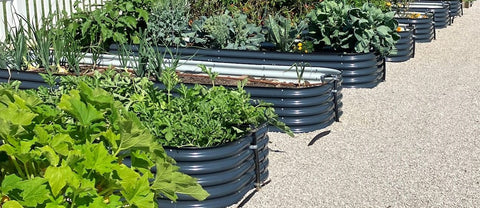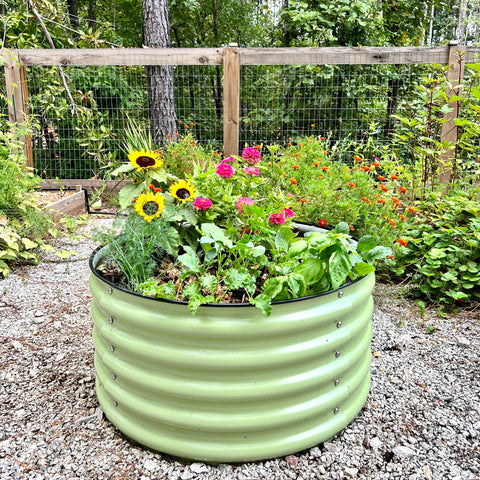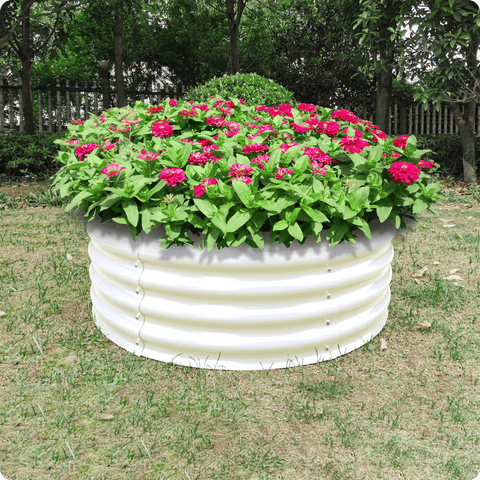Raised Gardens Beds vs. Traditional In-Ground Gardens – How to Decide
If you have just started to build a garden on a new property, or just built a garden on an old property, you may want to know whether it is more beneficial to build raised garden beds or directly plant it underground.
For some properties, especially those with barren, rocky or sandy soil, the raised garden beds have many advantages, rather than spending time, money and energy to regenerate the long neglected soil. For those who have healthy, nutrient rich and microbial rich soil, underground planting may be an easier way to take, because all you need to do is add a small amount of fertilizer and modify the soil between growing seasons.

As with most major businesses, it is not always easy to choose between a raised garden bed and gardening on the ground, and many factors should be considered before making a final decision. To help you make a decision, we have compiled a list of the pros and cons of the two options, outlining the pros and cons of raised garden beds and ground gardening. We also discussed the third option, container gardening, and explained why using all three media simultaneously is the most beneficial option for many gardeners.
The benefits of gardening with raised garden beds
- If the soil quality of a property is poor, building a raised garden bed may be a simple and feasible method, because it gives gardeners the opportunity to create a new, fertile and healthy soil environment that can be used immediately. It may take several years to regenerate barren soil, while the introduction of new soil rich in organic matter and microbial life can be completed in just a few hours.
- If your soil quality is poor, whether it is rock soil or clay heavy soil, or if you live in an area with heavy rain or rising groundwater levels, creating a raised garden bed is a simple way to end the problem of poor drainage and poor air circulation.
- The raised garden bed creates an elevated habitat, which heats up faster in spring, enabling gardeners to put plants underground faster and seize the opportunity in the growing season.
- Almost any type of plant can be planted on the garden bed. Vegetables, fruits, herbs, flowers, shrubs and small trees all grow well on the garden bed.
- The raised garden bed can keep some pests and rodents away from your plants. Before filling with soil, place the hardware cloth at the bottom of the garden bed to keep hamsters and other small burrowing creatures out of your garden.
- Compared with the underground garden bed, the garden bed is unlikely to receive traffic. By not stepping into the garden, it prevents the soil from becoming too compacted. It also helps prevent harmful microorganisms from riding on garden soil on shoes.
- Planting a raised garden bed can reduce the pressure on the back, and it is easier for people with mobility difficulties. Especially if you have beds that are 18 to 24 inches high or that are mounted on legs or wheels. Reducing hunchback, kneeling, leaning and exertion can work wonders in relieving back (and knee) pain.
- If the structure is excellent, the raised garden bed frame is very pleasing in aesthetics. Although the elevated bed does not need the side, the wood, concrete, stone or steel bed can add luster to your landscape. Cedar, hemlock, juniper and mahogany siding beds can add special appeal to your landscape. Elevated beds made of concrete blocks, natural stone, bricks, weather resistant steel and even hay or straw siding can also make your garden area look more attractive.
- The raised garden bed is easier to manage and work. Especially in a garden with limited space, it is easier to plant and harvest crops in a divided area.
- Once a raised garden bed is established, soil compaction is actually not a problem, which reduces the need for tillage between growing seasons. If your bed is well maintained and covered, weeding is not a problem.

Disadvantages of a raised garden bed
- Investing in a raised garden bed can be an expensive adventure. If you decide to use high-quality wood or stone siding, it may be particularly expensive. Starting a new garden requires buying compost, good soil, mulch, improvers, seedlings, gardening tools, etc. These items may not be expensive in themselves, but the cost may increase rapidly. Plus the cost of materials required for the raised garden bed, you may see expensive operations. Fortunately, the raised garden bed does not require a siding to function and can always be flanked on the road. However, the Olle garden bed is made of galvanized steel. It is not easy to corrode and damage compared with the wooden garden bed. Its service life can reach 20 years. There is no need to worry about easy wear and tear and replace the garden bed frequently. It seems that the cost of the raised garden bed is not that high.
- For plants with large roots, if trees or artichokes, garden beds are not the best choice, because they are not deep enough. The shallow layer is especially harmful to plants with large or dense roots.
Benefits of Underground Gardening
- Underground planting is usually much cheaper than creating garden beds garden areas.
- Underground planting provides more gardening space, which is particularly useful when using odd shaped areas of outdoor space.
- If you have healthy, well drained and fertile soil, it is unnecessary to spend a lot of time and energy to build a garden bed, because it is much easier to plant directly underground. All you need to do is add a small amount of fertilizer and soil conditioner and compost between growing seasons.
- Large gardeners and commercial growers usually like to work on garden beds. It is impossible to use machine operated plows and tractors for underground gardening.
Disadvantages of underground gardening
Ground gardening can be difficult on the back and knees because it requires a lot of bending, kneeling, hunching, exertion, and tilting. Underground planting operations can also be very dirty, so you need to use some old and unnecessary clothes for this task.
Garden pests, soil borne diseases, rodents and grazing animals may be more problematic in underground gardening than in garden beds. Excluding pests, diseases and other foragers from underground gardens can be a formidable challenge.
Ground-based gardening needs more water to properly irrigate your crops, because water tends to run off faster in larger spaces.
Revitalizing the soil on your property may take a long time. If your soil needs regeneration, it is difficult to successfully plant plants in the exhausted soil.
The bed on the ground is usually not as beautiful as the orderly garden bed.
And container gardening
The third method of home gardening is growing in containers. Containers are convenient because they can be easily moved when necessary. Some plants grow better in containers than underground. Invasive plants are particularly good for containers because they are unlikely to spread to unwanted areas when they are under control. The container is ideal for growing plants indoors and then moving them to the garden when the weather is warm. Container gardening is widely used and empowered, providing more freedom for gardeners in terms of function and design.

Provide examples for hybrid approaches
Fortunately, there are no rules or laws requiring gardeners to choose only one method and one method for their gardens. Using a hybrid approach makes sense for most gardens. Some garden beds on both sides of the house and in the backyard are ideal for organizing your fruits, herbs and gardens.
However, you may want to use the underground method to provide more design freedom for your front yard landscape. Adding containers to terraces, porches, indoor and outdoor garden areas will also help, and mixing these gardening methods will allow you to freely combine a more versatile, powerful, and beautiful garden and landscape on your property.
No matter what method you choose, do not feel that you must persist in the foreseeable future. Your garden should be an organism that is constantly developing and improving. It's good to choose a raised garden bed or an underground bed, but it's foolish to decide that your decision is permanent. There are no strict rules on garden design. Therefore, for a great garden, please mix it up at any time and change it when you feel impulsive.
